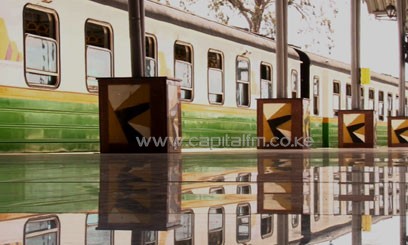 NAIROBI, Kenya, Nov 13 – The letters in red beckon you off the road. They seem to say, ‘turn in here and forget the traffic’.
NAIROBI, Kenya, Nov 13 – The letters in red beckon you off the road. They seem to say, ‘turn in here and forget the traffic’.
Turning into the gate you notice there are still a few finishing touches that remain to be made. The construction of the parking lot, for instance, hasn’t been completed and tires crunch on stone as you drive on them.
All along the road the building shoulders, are warehouses and the station looks like a cross between one and a hypermarket.
My shoes click as I walk past glass doors and onto white and black tile. On my left is a pair of elevators, on my right a pair of escalators; as with most pairs of escalators, one going up, and one going down. I’m warned off the elevators by a grey haired woman who whispers to her companion, “they need to check those doors.” Escalator it is.
But not before I marvel at the bronze goddess who stands one hand pointed to the sky. She sits at the centre of the station. Which is fitting given the train station is named after her. Her name is Syokimau. I remember learning about her in school. She was a prophetess. She lived four centuries ago, among the Akamba people up the road. The road that leads up to Machakos county.
A plaque sits below her statue. It tells a story I heard a long time ago. Syokimau prophesied a snake with many legs would make its way from the direction of the ocean and it would bring with it men who had fire in their pockets.
Her predictions don’t sound as crazy today as they might have then if you agree with the position that the snake with many legs symbolised the train and fire in the pocket, guns.
There’s nothing much to see up the stairs. But if I shut my eyes I can almost see people sitting and chatting over a cup of tea as they watch the television screens that display the train timings, waiting to be on their way.
Right behind Syokimau is a row of red, plastic gates. And beyond them, freshly painted in green and yellow, are the trains. The ticket counters are hard to miss, their walls bathed in red.
A hundred shillings lighter and a ticket swipe later, I’m past the gates and behind a yellow line as I wait to make my maiden voyage on the Nairobi Commuter Rail Service.
Behind me a bespectacled lady struggles with her ticket. Every time she tries to go past the red gates, a shrieking sound fills the air. I’m taken back to Korea, the first time I used a subway. I too had trouble with the gates and wondered how the natives made their way through so effortlessly. I felt trapped until a cleaning lady let me pass through the staff gate. The red ‘x’ above the bespectacled lady’s gate, to her relief I imagine, finally turns green after many attempts.
The seats in here are green too. They stand against the sides of the carriage such that you look into the face of the person sitting opposite you. Yellow handle bars dangle from the roof. Not that you’d jerk forward should the train come to a stop like you would in a bus, or a fast moving train. This train moves slowly, a bit like a ship out in the sea. If you’re prone to sea sickness you might want to skip the ride.
The turning of the wheels, the sound of the engine, everything you were taught to expect from a train growing up. Train attendants clad in green waistcoats go up and down the aisle checking tickets. Time moves slowly. They said it would take about half an hour to get to the city centre but staring out at the pulled down windows at the grass and children running after the train, it seems miles and miles away from the hustle and bustle.
I’m reminded that the last time the railway was extended and a station put up was 80 years ago in Butere. The construction of what was called a ‘Lunatic line’ by the member of the British legislature having began close to a hundred years ago.
As I look out at the grass I picture the lions that must have lay in wait for the railway construction workers in Tsavo all those years ago. The man eaters of Tsavo picked them off one by one. The 120 workers who built the 2kms of rail on which I ride needn’t have worried too much about that given all the development in the area.
The line has many stories to tell. It holds the secrets of many greats; Queen Elizabeth, one time American President Theodore Roosevelt and Winston Churchill, the British Prime Minister who led the United Kingdom to victory during World War II and who we love to quote, riding on it.
The movement of the train could rock you to sleep. The quiet bubble breaks as the stone building that is the Nairobi station comes into view. Here there are no glass doors, no plastic gates. Beyond the stone walls is noise. Noise emanating from the activity surrounding the hordes of matatus beyond it.
The matatu being the means of transport many Kenyans have come to depend on until now. The train until now having been, as the chairman of Kenya Railways says, known for, “poor services, dilapidated infrastructure, and financial neglect.” Only time will tell if the Syokimau train station is a shedding off of the past and a step forward in the realisation of the Kenyan dream.









































